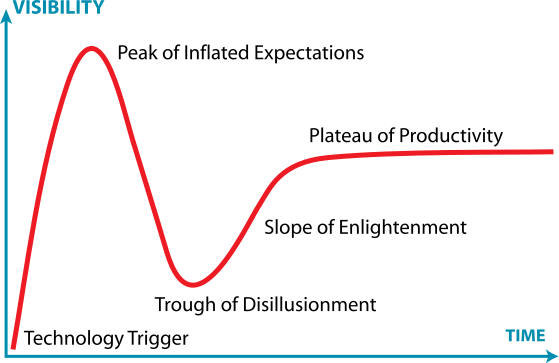Usually, I like to start a new year on an upbeat note, but this time I just cannot find the right fit. I was considering whether to revisit technology that can clean water – lauding the effort of the Bill Gates foundation came to mind, but while I think this is a great step in the right direction, this water reclaiming technology is still a bit too complex and expensive to become truly transformational and liberating.
At other times, a groundbreaking progress in increasing the efficiency of solar energy would have qualified, the key being that this can be done comparatively cheaply. Alas, the unprecedented drop in the price of oil is not only killing off the fracking industry, but also the economics for alternative energy. For a planet that has had its fill of CO2, fossil fuel this cheap is nothing but an unmitigated disaster.
So while it was a banner year for quantum computing, in many respects 2014 was utterly dismal, seeing the return of religiously motivated genocide, open warfare in Europe, a resurgence of diseases that could be eradicated by now, and a pandemic that caused knee jerk hysterical reactions that taught us how unprepared we are for these kind of health emergencies. This year was so depressing it makes me want to wail along to my favorite science blogger’s song about it (but then again I’d completely ruin it).
And there is another reason to not yet let go of the past, corrections:
- No, there isn’t really any evidence for primordial gravity waves in the cosmic background radiation (h/t Sol Warda). I was pretty careful in reporting on this originally, and the smack down kept on coming until this retraction has now gone mainstream. (Of course it’s not like this is unprecedented).
- Neither does the purported correlation of Beta decay with solar radiation hold up. This was always a far stretch, but one that would have been extremely exciting, so I am glad to see that there has been yet another independent follow-up. At this point, I think the matter has been settled.
With these corrections out of the way I will finally let go of 2014, but with the additional observation that in the world of quantum computing, the new year started very much in the same vein as the old, generating positive business news for D-Wave, which managed to just raise another 29 million dollars, while at the same time still not getting respect from some academic QC researchers.
I.H. Deutsch (please note, not the Deutsch but Ivan) states at the end of this interview:
- [1]The D-Wave prototype is not a universal quantum computer.
- [2]It is not digital, nor error-correcting, nor fault tolerant.
- [3]It is a purely analog machine designed to solve a particular optimization problem.
- [4]It is unclear if it qualifies as a quantum device.”
No issues with [1]-[3]. But how many times do classical algos have to be ruled out before D-Wave is finally universally accepted as a quantum annealing machine? This is getting into climate change denying territory. It shouldn’t really be that hard to define what makes for quantum computation. So I guess we found a new candidate for D-Wave chief critic, after Scott Aaronson seems to have stepped down for good.
Then again, with a last name like Deutsch, you may have to step up your game to get some name recognition of your own in this field. And there’s no doubt that controversy works.
So 2015 is shaping up to become yet another riveting year for QC news. And just in case you made the resolution that, this year, you will finally try to catch that rainbow, there’s some new tech for you.

Update: Almost forgot about this epic fail of popular science reporting at the tail end of 2014. For now I leave it as an exercise to the reader to spot everything that’s wrong with it. Of course most of the blame belongs to PLoS ONE which supposedly practices peer review.

 The ‘god particle’, aka the Higgs boson, received a lot of attention, not that this wasn’t warranted, but I can’t help but suspect that the justification of the CERN budget is partly to blame for the media frenzy.
The ‘god particle’, aka the Higgs boson, received a lot of attention, not that this wasn’t warranted, but I can’t help but suspect that the justification of the CERN budget is partly to blame for the media frenzy. 






